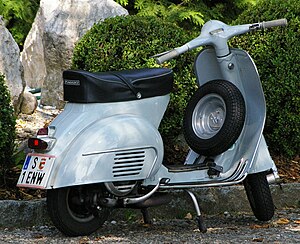Vespa 125
| Vespa | |
|---|---|

|
|
| Vespa 125 | |
| Manufacturer | Piaggio |
| Production period | 1948 to 1969 |
| class | Scooter |
| Motor data | |
| transmission | 3-speed, 4-speed (manual transmission) |
| Brakes | Drum brakes |
| Wheelbase (mm) | 1180 |
| Dimensions (L × W × H, mm): | 1735 × 655 × 895 |
| Empty weight (kg) | 83/87 |
| Previous model | Vespa 98 |
| successor | Vespa 125 GT |
The Vespa 125 was a motor scooter from the manufacturer Piaggio , which sells its classic product line under the brand name Vespa . The successful model was offered from 1948 to 1969.
History and technology
The Vespa 125, which was based on the Vespa 98 , differed from the original Vespa in its 125 cm³ engine and a revised shift linkage. The carburetor had a choke that was operated with a lever attached under the saddle. In contrast to the band springs of the Vespa 98, the front swing arm now had a coil spring. The rear wheel was also sprung, which is why the circular opening in the engine cover on the Vespa 98 was opened downwards so that the engine could swing. The saddle was also better suspended.
With the model presented in 1957, Piaggio ended the era of the series with the headlamp sitting on the fender ("lamp below") and presented a new model series that consisted of two longitudinally welded sheet metal halves that could be produced in a more rational production process and were called large frames . From a technical point of view, the engine swing arm is now also the left engine half and the cooling air duct has been integrated into the right engine half. The handlebars have also been completely redesigned. The Vespa 150 followed a year later ; from both the Vespa 125 Super and the Vespa 150 Super were derived and, in addition, with the Vespa 150 GL and the Vespa 125 GT, a larger model series was derived and the rally models up to the Vespa Rally 200 were also created. The chassis introduced here remains in the program until 1979 due to ongoing revisions.
The first series VNA1T and VNA2T still had a three-speed gearshift and had to be started with a kick starter.
The VNB was presented together with its big sister VBA at the end of 1959. Like this, the VNB also has a rotary valve-controlled motor that can be driven with a 2% petrol-oil mixture. A battery was also standard initially, but could later be deselected. With each series, minor modifications are made to the chassis, technology and add-on parts so that they can be identified by the lettering, the lighting or the speedometer. A fourth gear has arrived with the VNB5T.
The VNC presented as Vespa 125 Super is the last Vespa on 8 "wheels, but both wheels now have self-ventilating brake drums. The slightly modified body looks a bit more angular, the jaws have an aluminum trim and there are 5 slots on the engine side.
The successor is the Vespa 125 GT , which takes over the engine but is based on a heavily modified frame.
First model series
| Vespa 125 | |||||||
|---|---|---|---|---|---|---|---|
| construction time | 1948-1950 | 1950-1952 | 1952-1953 | 1953 | 1953-1954 | 1954-1955 | 1956-1957 |
| Frame number prefix | V1T | V30T | VM1T | VU1T | VM2T | VN1T | VN2T |
| Engine type | Two-stroke single cylinder | ||||||
| Mixture preparation | Carburetor | ||||||
| Displacement | 123.7 cm³ | ||||||
| Bore × stroke (mm) | 54 × 54 | ||||||
| Max. Power (PS) at min |
4.5 / 4500 | ||||||
| Top speed | 70 km / h | ||||||
Second model series
| Vespa 125 | Vespa 125 Super | ||||||||
|---|---|---|---|---|---|---|---|---|---|
| construction time | 1957-1958 | 1958-1959 | 1959-1961 | 1961 | 1961–1962 | 1962-1963 | 1963-1964 | 1964-1966 | 1965-1969 |
| Frame number prefix | VNA1T | VNA2T | VNB1T | VNB2T | VNB3T | VNB4T | VNB5T | VNB6T | VNC1T |
| Engine type | Two-stroke single cylinder | ||||||||
| Mixture preparation | Carburetor | ||||||||
| Displacement | 123.7 cm³ | 123.4 cm³ | |||||||
| Bore × stroke (mm) | 54 × 54 | 52.5 × 57 | |||||||
| Max. Power (PS) at min | 4.6 / 5100 | 5/4800 | |||||||
| Top speed | 75 km / h | 78.5 km / h | 75 km / h | 85 km / h | |||||
Trivia
In France the VNA was built under license as Vespa ACMA 125 Type N and in Germany the VNB as Vespa 125 Augsburg Type 232 and Type 392.
Web links
literature
- Lutz-Ulrich Kubisch, Günther Uhlig: Vespa. 1st edition. Motorbuch Verlag, Stuttgart 2014, ISBN 978-3-613-03672-7 .
- Roberto Leardi, Luigi Frisinghelli, Giorgio Notari: Vespa Tecnica '56 - '64. Volume 2, CLD Libri, Pontedera 2004, ISBN 88-87748-37-3 .